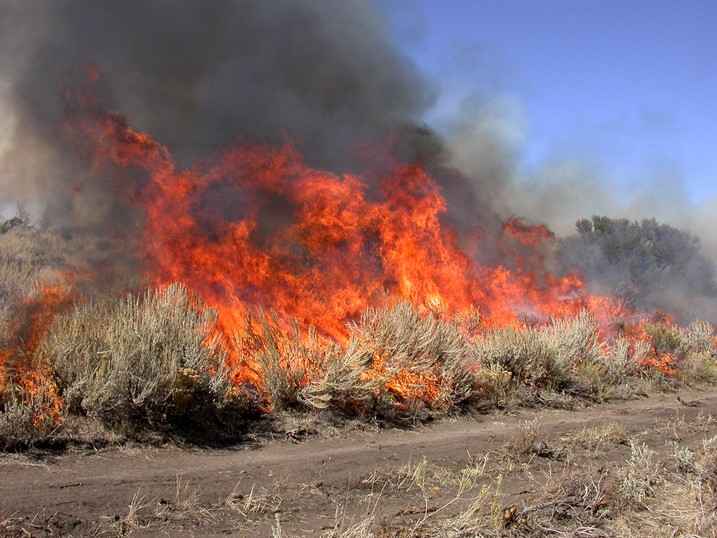| News |

|
GRAZE TO REDUCE THE BLAZE
Ranching and cattle grazing efforts now reduce wildfire fuels for the summer.
OWYHEE COUNTY, IDAHO May 22, 2023 - The herd of black and brown cows and their calves idly grazing just off the road in the Owyhee Front are unfortunately completely unaware of the important purpose they’re serving.
This spring, the cheatgrass in the rangeland is tall and green and full of nutrition for the ranging cattle. When the invasive species is allowed to keep growing long and tall, it eventually dries out during the hot months and becomes extremely flammable.
Livestock grazing on public lands is one tool state and federal land managers are using to reduce wildfire fuels. This doesn’t prevent fires from happening, but will hopefully help slow them down or keep them from growing out of control.
“Livestock play an important role in helping us reduce fine fuel loading out there on our rangelands,” Idaho Department of Lands Director Dustin Miller said. “Proper grazing is a good thing on rangelands. It helps stimulate the production of natural bunch grass communities, helps reduce fuel loading and decrease the risk of catastrophic fire and it’s beneficial for wildlife that utilize the range as well.”
The department is involved in improving habitat conditions for greater sage grouse recovery efforts, which also improves forage potential for livestock grazing, he said. For example, the department is using grants to remove juniper trees that have encroached on areas they hadn’t grown in before. This opens up the canopy and stimulates growth of native sagebrush and bunch grasses — this is beneficial to wildlife and livestock.
With the heavy precipitation at the beginning of spring in Idaho, the range could see a lot of what’s known as fine fuels; these are fast-drying foliage, such as grasses and twigs. They typically cover a lot of surface area, ignite readily and are rapidly consumed by fire, according to the U.S. Department of Agriculture.
Ranchers who get permits to graze on public land are held to strict standards, including grazing plans for each individual allotment that regulate timing, how many animals the land can support, and requirements to maintain fencing and protect riparian areas.
TARGETED GRAZING
In the case of the Owyhee Front, a large fire in 2015 has led to an experiment in using grazing to prevent another fire from becoming so destructive. After the Soda Fire, a pilot project was launched by the Bureau of Land Management in the region to create fire breaks on the landscape, which would serve to slow down a fire and provide a safer area for firefighters to work from.
Some of the fire breaks are mowed; 200 meters on either side of the road is trimmed down to help slow down a fire. And some of the fire breaks are grazed, with targeted heavier grazing by the ranchers who lease in the area.
These efforts in the lowlands will also hopefully protect the uplands in the area, which is where more wildlife such as the sage grouse reside, said rancher Brenda Richards, Idaho Rangeland Conservation Partnership coordinator.
In 2018, the BLM began implementing the targeted grazing project in which ranchers graze livestock along 36 miles of Owyhee Front roadways from around Marsing to Murphy.
“We’ve made important gains in rehabilitating the area burned in the Soda Fire with the help of many partners,” BLM Boise District Manager Lara Douglas said in a 2018 release. “Targeted grazing allows us to experiment with a new tool to protect those gains, while at the same time supporting traditional land uses.”
Targeted grazing has been used in other Great Basin locations, such as Frenchglen, Oregon, and Elko, Nevada. U.S. Department of Agriculture rangeland scientist Pat Clark said on the USDA website that this method can be implemented at a lower cost than mechanical methods....
Read the full article from Linda Guido at the Idaho Press here.
Firefighting Cattle: Targeted Grazing Creates Firebreaks in Cheatgrass
BOISE, IDAHO, October 2, 2020 - Cattle grazing on a nearly half mile wide targeted strip of cheatgrass near Beowawe, Nevada, created a firebreak that helped limit a range fire to just 54 acres this past August compared to rangeland fires that more commonly race across thousands of acres of the Great Basin each summer.

This same grazed fuel break held the Boulder Creek Fire to just 1,029 acres in July 2018 and kept the fire out of sage-grouse habitat located downwind.
These “targeted grazing” firebreak and 8 others are part of an evaluation project being managed by the Agricultural Research Service (ARS). The agency is partnering with the Natural Resources Conservation Service (USDA) and Department of the Interior agencies as well as state and local authorities and local cattle ranchers in Idaho, Nevada and Oregon. The demonstration sites are being coordinated into a Multi-Regional Experiment so the targeted grazing concept’s efficacy and environmental impacts can be uniformly evaluated and compared. DOI Bureau of Land Management (BLM) is funding much of the program.
“The basic idea is to use cattle grazing in the early spring to mow extensive strips of highly-flammable cheatgrass down to 2- to 3-inch stubble in strategic places to remove the fuel that can turn small rangeland fires into megafires in a matter of hours. These fuel breaks are intended to slow fire spread, make it less intense, and provide places from which firefighters can more safely attack and contain the fire,” explained ARS rangeland scientist Pat Clark with the Northwest Watershed Research Center in Boise, Idaho, who directs the targeted grazing evaluation project.
Read the full article here at the Post Register
ARS News Articles

